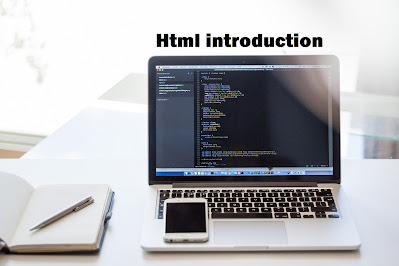HTML Introduction:
 |
| Html introduction- |
HTML represents HyperText Markup Language. It is utilized to configure website pages utilizing a markup language. HTML is the blend of Hypertext and Markup language. Hypertext characterizes the connection between site pages. A markup language is utilized to characterize the text record inside the label which characterizes the design of website pages. This language is utilized to explain (make notes for the PC) text with the goal that a machine can figure out it and control text likewise. Most markup dialects (for example HTML) are comprehensible. The language utilizes labels to characterize what control must be finished on the text. HTML is a markup language utilized by the program to control text, pictures, and other substances, to show it in the expected configuration. HTML was made by Tim Berners-Lee in 1991. The very first adaptation of HTML was HTML 1.0, yet the main standard form was HTML 2.0, distributed in 1995.
<!DOCTYPE html>:
This is the record-type statement (not in fact a tag). It pronounces a report similar to an HTML record. The doctype statement isn't case-delicate.
<html>:
This is known as the HTML root component. Any remaining components are held inside it.
<head>:
The head tag contains the "in the background" components for a site page. Components inside the head aren't noticeable toward the front of a website page. HTML components utilized inside the <head> component include:
<style>-
This HTML tag permits us to embed styling into our website pages and make them interesting to take a gander at with the assistance of CSS.
<title>-
The title is shown on the highest point of your program when you visit a site and contains the title of the page that you are seeing.
<base>-
It determines the base URL for all general URL's in a report
<noscript>-
Characterizes a part of HTML that is embedded while the prearranging has been switched off in the client's program.
<script>-
This tag is utilized to add usefulness to the site with the assistance of JavaScript.
<meta>-
This tag encases the meta information of the site that should be stacked each time the site is visited. For eg:- the metadata charset permits you to involve the standard UTF-8 encoding in your site. This thus permits the clients to see your website page in their preferred language. It is a self-shutting tag
<link>-
The 'connect' tag is utilized to integrate HTML, CSS, and JavaScript. It is self-shutting.
<body>: The body tag is utilized to encase all the noticeable substance of a page. At the end of the day, the body content is what the program will show toward the front.
An HTML archive can be made utilizing any content manager. Save the text document utilizing .html or .htm. When saved as an HTML record, the document can be opened as a page in the program.
About HTML
HTML addresses Hyper Text Markup Language.
HTML is a hyperactive extravagance language' for fostering Web sprinters.
HTML is a language that plans the Web sprinter.
HTML contains a movement of elements.
HTML factors encourage the program how to show the substance.
HTML factors mark pieces of content, for the outline," this is a section"," this is a line and segment"," this is a connection, etc.
it is the most broadly utilized language to compose Web sprinters.
- Hypertext alludes to how Web sprinters( HTML reports) are associated together. Consequently, the association opens on a sprinter is called Hypertext.
- As its name proposes, HTML is a Markup Language that infers you use HTML to simply" increment" a course reading record with markers that exhort a Web program how to structure it to show. initially, HTML was made fully intent on describing the development of libraries like titles, sections, records, and so on to work with the isolating of intelligent information among judges.
By and by, HTML is overall by and large used to orchestrate site sprinters fully backed up by vivid markers open in HTML language
Use of HTML
HTML has a lot of direction cases, specifically:
- Web Development. Engineers use HTML code to arrange how a program shows site page parts, similar to text, hyperlinks, and media reports.
- Web Navigation. Clients can without a very remarkable stretch investigate and install joins between related pages and destinations as HTML is vivaciously used to embed hyperlinks.
- Web documentation. HTML makes it possible to figure out and coordinate documents, correspondingly to Microsoft Word.
This article will go over the purposes of HTML, including how it works, its benefits and impediments, and how it interfaces with CSS and JavaScript.
Basic HTML Coding
<!DOCTYPE> <html> <title> my first web </title> <body> <h1> I am new webdeveloper </h1> <p> my first web coding start from here ! </p> </body> </html>
Possibly you can utilize the Try it choice accessible at the upper right corner of the code box to check the
consequence of this HTML code, or we should save it in an HTML record test.htm utilizing your number one text
manager. At long last open it utilizing an internet browser like Internet Explorer or Google Chrome, or Firefox.



